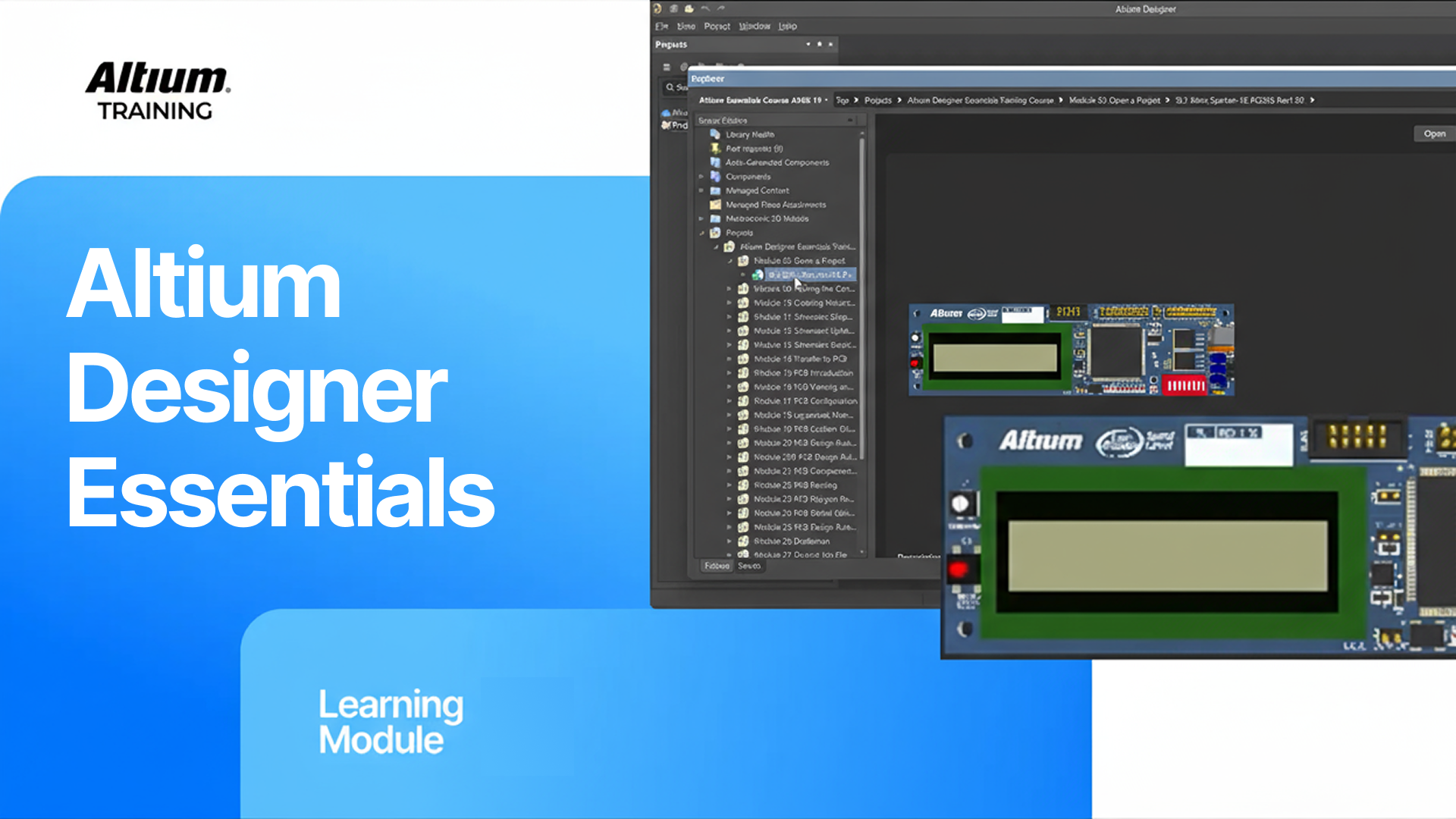Projectsパネル
Projectsパネルは、現在開いているすべてのプロジェクトとそれらの構成文書および構造を表示します。パネルの右クリックコンテキストメニューは、設計文書を操作するために必要なほとんどのコマンドを提供します。

Projectsパネル
Projectsパネルにおける文書の表示は、ハードドライブや他の場所にどのように保存されているかを反映していないことに注意してください。このパネルの内容はプロジェクトの論理的な表現とみなすことができるのに対し、文書ファイルの物理的な場所と整理(およびその種類)はあなた次第です。文書はローカルマシンやLAN上のフォルダに保存されている場合もあれば、もちろん基本的なGit/SVN VCSシステムやワークスペースのような完全に管理されたシステムが提供するバージョン管理リポジトリにホストされている場合もあります。
Projectsパネルの振る舞いは、PreferencesダイアログのSystem – Projects panelページのPreferencesダイアログを使用して設定できます。これらのオプションには、パネルの上部にある コントロールを使用してもアクセスできます。
コントロールを使用してもアクセスできます。
Workspaceに接続している場合、Workspaceアイコン( /
/ )がこのWorkspaceの最上位エントリの隣に表示されます。プロジェクトのローカル作業コピーが開かれているが、プロジェクトが存在するWorkspaceに接続されていない場合、グレーアウトされたWorkspaceアイコン(
)がこのWorkspaceの最上位エントリの隣に表示されます。プロジェクトのローカル作業コピーが開かれているが、プロジェクトが存在するWorkspaceに接続されていない場合、グレーアウトされたWorkspaceアイコン( /
/ )が表示されます。
)が表示されます。
Workspaceプロジェクトは、そのWorkspaceのチームに招待されずに共有されることもあります。共有アクセスから開かれたプロジェクトは、それに関連するShared with meラベルとその隣のアイコンによって示されます。
プロジェクトが共有された場合、それを閲覧のみ可能であることを示すView Onlyラベルがパネルのプロジェクトエントリの隣に表示されます – 例を表示。
ローカルプロジェクトは、プロジェクトグループエントリ(
*.DsnWrk)の下にリストされます – デフォルトのもの(Project Group 1.DsnWrk)か、作成または開いたものです。
現在接続しているWorkspaceに関するコンテキストメニューにアクセスするには、Workspace名を右クリックするか、その右端にある コントロールをクリックします。これらのコマンドには以下が含まれます:
コントロールをクリックします。これらのコマンドには以下が含まれます:
-
Open Project – Open Projectダイアログを開きます。
-
Create Project – Create Projectダイアログを開きます。
-
Show in Explorer – Explorerパネルを開きます。
-
Show in Web Browser – デフォルトのブラウザでWorkspaceのブラウザインターフェースのProjectsページを開きます。
-
Sign out – Workspaceからサインアウトします。
-
Sign in – Workspaceにサインインします。このコマンドは、プロジェクトパネルで少なくとも1つのWorkspaceアイテム(例えば、プロジェクト)が開かれており、そのアイテムが存在するWorkspaceから現在切断されている場合に利用可能です。
これらのコマンドにアクセスするには、Workspaceに接続している必要があります。Workspaceからサインアウトした場合、接続したいWorkspaceを右クリックし、Sign inコマンドをクリックします。
-
ProjectsパネルにリストされているWorkspaceプロジェクトのウェブビューアを開くには、そのエントリを右クリックしてShow in Web Browserコマンドを選択するか、メインメニューからProject » Show In Web Browserコマンドを選択します。プロジェクトをExplorerパネルで表示するには、Show in Explorerコマンドを選択するか、メインメニューからProject » Show In Explorerコマンドを選択します。
-
アクティブなWorkspaceプロジェクトのAssemblyビューは、メインメニューからProject » Assembly Assistantコマンドを使用してアクセスできます。
プロジェクト文書ツリー
既存のプロジェクトを開いたり、新しいプロジェクトを作成したりすると、そのエントリがプロジェクトパネルに表示されます。プロジェクトの一部である既存の文書(および追加された新しい文書)は、その目的および/またはタイプに応じてサブフォルダの下に表示されます。たとえば、以下の一般的なフォルダとコンテンツ文書タイプがプロジェクトの下に表示されることがあります:
-
ソース文書 – 回路図、PCBなどのコア設計文書。
-
設定 – プロジェクト内で使用されるさまざまなファイルを提供し、出力ジョブファイル、ハーネス定義ファイル、注釈文書など、その他の関連ファイルを含みます。
-
Libraries – ローカルソースライブラリの文書。文書はライブラリの種類(例:スキーマライブラリ、PCBライブラリなど)に基づいてさらに細分化されます。
-
Documentation – Altium Designerに知られているタイプの追加文書(例:テキスト、PDFなど)がプロジェクトに追加されました。
-
Other Documents – Altium Designerが知らないタイプの追加されたドキュメントがプロジェクトに追加されています。これらは、所有アプリケーションがWindowsによって知られている場合(例:Word文書、Excelスプレッドシートなど)、Altium Designerで開くことができます。
-
Generated – 出力として生成された文書。文書はさらにタイプ(例:BOM文書、テキスト文書など)に基づいて細分化されます。プロジェクトの出力が生成されると、メインツリー内の対応するサブフォルダが作成され、内容が埋まっていきます。
-
Components – このフォルダには各コンポーネントと各グループ内のコンポーネントの数が一覧表示されています。このフォルダが表示されない場合はプロジェクトを検証してください(Project » Validate)。コンポーネントはデフォルトでデザインネーターの最初の文字でグループ化されます - コンポーネント(またはコンポーネントグループフォルダ)のエントリを右クリックし、コンテキストメニューからComponent Groupingコマンドを選択すると、ProjectsパネルのComponent Groupingコントロールに迅速にアクセスし、グループ化のスタイルを変更したり、必要に応じてグループ化を無効にしたりできます。詳細については、回路接続の作成ページのプロジェクト構造におけるコンポーネントとネットの検索セクションを参照してください。
-
Nets – このフォルダには、プロジェクトで使用される各ネットがリストされています。このフォルダが表示されない場合は、プロジェクトを検証してください(Project » Validate)。詳細を知るには、回路接続を作成するページのプロジェクト構造内のコンポーネントとネットの検索セクションを参照してください。
プロジェクトフォルダまたはプロジェクトフォルダのサブフォルダに保存されたドキュメントは、相対参照を使用してプロジェクトファイルに関連付けられています。異なるフォルダパスに保存されたドキュメントは、絶対参照を使用してプロジェクトファイルに関連付けられています。これらのドキュメントには、上の画像で示されている ファイルのように、プロジェクトにリンクされていることを示すために、隅に小さな矢印が表示されています
ファイルのように、プロジェクトにリンクされていることを示すために、隅に小さな矢印が表示されています
ドキュメントツリーでの作業に関するメモ:
-
プロジェクトに依存しない任意の文書はFree Documentsとして表示され、対応するサブフォルダの下に表示されます。フリードキュメントを右クリックし、コンテキストメニューからAdd to Project <ActiveProjectName>コマンドを選択することで、現在開いているフリードキュメントをアクティブプロジェクトに追加できます。あるいは、Projectsパネルで必要なプロジェクト名にドラッグアンドドロップすることもできます。
-
複数のドキュメントを同時に編集することを可能にするだけでなく、この環境では複数のプロジェクトを同時に開くこともサポートしています。これらのプロジェクトは関連している場合もあれば、無関係な場合もあります。
-
複数のドキュメントを同時に編集することを可能にするだけでなく、この環境では複数のプロジェクトを同時に開くこともサポートしています。これらのプロジェクトは関連している場合もあれば、無関係な場合もあります。
-
新しい階層設計の場合、ドキュメント間の親子関係はパネルに表示されます。回路図ドキュメントのドラッグアンドドロップによって接続関係を定義することはできないので注意してください。インターシート接続と設計階層は、実際にはシートシンボルとポート定義によって定義されます。
-
プロジェクトドキュメントのサブフォルダを右クリックすると、展開されているか閉じているかに関係なく、焦点を当てたプロジェクトドキュメントのサブフォルダ内のすべてのドキュメントを開く、閉じる、または保存するなどの追加のドキュメント管理コマンドにアクセスできます。
-
ドキュメントは、クリックしてドラッグすることでパネル内のプロジェクト間で転送できます。ドキュメントは正しいサブフォルダにドラッグする必要はなく、プロジェクト構造内で自動的に正しく配置されます。
-
キーボードショートカット上矢印、Home、End、下矢印を使用して、パネル内の前のエントリ、最初のエントリ、最後のエントリ、次のエントリをそれぞれ表示できます。右矢印キーと左矢印キーを使用して、トップレベルのエントリまたはそのサブフォルダをそれぞれ展開および折りたたむことができます。
-
選択したコンポーネントまたはネットエントリをプロジェクトパネルから親PCB設計プロジェクトの回路図またはPCBドキュメントにクロスプローブするには、エントリを右クリックしてコンテキストメニューからCross Probe to SchematicまたはCross Probe to PCBコマンドを選択します。
-
プロジェクトドキュメントが保存されている場所でWindowsエクスプローラーのインスタンスを開くには、プロジェクトパネル内のそのエントリを右クリックしてExploreコマンドを選択します。Projectsパネルでフォーカスされているドキュメントについては、パネルの上部にある 
 コントロールをクリックすることで行うことができます。
コントロールをクリックすることで行うことができます。
プロジェクトオプション
既存のプロジェクトまたは新しく作成されたプロジェクトは、そのプロジェクトに特有の一連のオプション設定と関連付けられています。これらはプロジェクトファイル(例:*.PrjPcb)に保存され、プロジェクトの種類によって異なります。
オプション設定は、メインメニューのProject » Project OptionsからアクセスできるProject Optionsダイアログで構成されます。または、Projectsパネル内のプロジェクト名を右クリックしてコンテキストメニューからProject Optionsを選択します。Projectsパネルでフォーカスされているプロジェクトの場合、パネルの上部にある コントロールをクリックすることでダイアログにアクセスできます。
コントロールをクリックすることでダイアログにアクセスできます。
プロジェクトファイルに保存される他のプロジェクト設定には以下が含まれます:
-
回路図のアノテーション設定。
-
出力設定(レポート、印刷、ガーバーなど)。これらは回路図またはPCBエディターメニュー経由でアクセスされる出力設定であり、OutJobドキュメントで定義された出力設定とは異なります。
ドキュメントステータスの表示
Altium Designerでプロジェクトドキュメントを扱う際、プロジェクトパネルは、各設計ドキュメントおよびメインプロジェクトファイルに関連付けられたステータスアイコンを通じて、どのドキュメントファイルが変更されたか、保存されたかの視覚的な要約を提供します。これにより、ドキュメントが変更されたか、保存されたか、ワークスペース内かローカルか、およびバージョン管理のステータスが一目でわかります。ドキュメントアイコンとその意味は以下の通りです。
開いている/変更されたステータスアイコン
変更された文書またはプロジェクトは、Projectsパネルのエントリの横にアスタリスクが付いていることで区別されます。変更された文書も、メインエディタウィンドウのタブ内にアスタリスクが表示されることで示されます。ファイルロックが有効になっている場合(データ管理 – ファイルロックを参照)、パネル内の文書に関連付けられたアイコンは、ファイルがこのAltium Designerのインスタンスによって開かれているか、変更されているか、開かれていてロックされているか、または別のAltiumソフトウェアのインスタンスによって開かれていてロックされているかを示します。ファイルロックに関係なく、変更された文書は、ファイル名に関連付けられたアスタリスクによって示されます。
バージョン管理ステータスアイコン
バージョン管理システムは本質的に作業フォルダ内の文書ファイルを設計リポジトリー内の対応するファイルと監視・比較します。Altium Designerは、VCSインターフェースを介してバージョン管理システムと情報を要求し交換し、比較ファイルの状態に応じて応答します。実際には、これがプロジェクトファイルアイコン、さまざまなVCS警告、利用可能なファイル管理コマンドの適切な変更として現れます。
-
パネルの右クリックメニューからHistory & Version Control » Refreshオプションを選択するか、メインメニューからProject » History & Version Control » Refreshコマンドを選択する(またはF5を押す)ことで、各ドキュメントエントリの現在のVCSステータスを更新します。これは、作業フォルダ内のドキュメントと設計リポジトリ内の対応するドキュメントを比較し、各ドキュメントのステータスをそれに応じて更新します。
-
VCSアイコンにカーソルを合わせると、その意味の定義が表示されます。
-
VCSアイコンをクリックすると、文書のVCSステータスに関する詳細情報と関連する操作を行うためのアクセスオプションが得られます。
アイコンとその意味は以下の通りです:
| 空白 |
N/A |
この文書はVCSリポジトリでバージョン管理されていません。 |
 |
変更なし |
ローカルにある文書のコピーはリポジトリの文書と一致しており、最新の状態です。 |
 |
追加予定 |
ドキュメントはバージョン管理に追加されましたが、まだVCSリポジトリにコミット(チェックイン)されていません。 |
 |
変更済み |
ドキュメントのローカルコピーが修正され、作業フォルダに保存されました。リポジトリに新しいリビジョンを作成するためにドキュメントをコミットしてください。PCBドキュメントの場合、PCB CoDesign機能を使用してProjectsパネルのHistory & Version Control » Compare To右クリックメニューまたはプロジェクトのProjects » History & Version Control » Compare To メインメニューから、 Local Changes to Remote Document Versionコマンドを使用して、ローカルの変更をワークスペースの最新のコミットと比較することもできます。
|
 |
Out of date |
ローカルのドキュメント(作業フォルダ内)がリポジトリ内の対応するドキュメントより古いため、古くなっています。ProjectsパネルのHistory & Version Control右クリックメニューからUpdate Project From Serverコマンドを使用するか、Projects » History & Version Controlメインメニューを使用して、ワークスペースから最新のドキュメントを取得してください。
この状態でドキュメントを保存すると、競合状態が発生します。プロジェクトに古くなったものと変更なしの状態のドキュメントのみが含まれている場合、プロジェクトパネルのプロジェクト名の横に表示されるUpdate from Serverコントロールを使用して、ワークスペース(画像を表示)から古いドキュメントの最新のドキュメントを取得することもできます。
|
 |
Conflict Prevention |
他のユーザーがあなたが編集してローカルに保存したその文書をコミットする前に文書をコミットしました。プロジェクト文書のローカル変更を破棄するには、バージョン管理のRevert Local Changes コマンドを使用してください。PCB文書の場合は、PCB CoDesign機能を使用して変更を比較し、マージすることもできます。 |
 |
Conflict Detected |
プロジェクトがConflict Prevention状態のドキュメントを含む場合、ワークスペースにプロジェクトを保存しようとすると、これらのドキュメントはConflict Detected状態になります。解決が必要な競合ドキュメントをリストアップするAction Required情報ダイアログが表示されます。ProjectsパネルのHistory & Version Control » Resolve Conflict右クリックメニューから次のコマンドを使用して競合を解決してください:
-
Compare To Remote Version & Merge - このコマンドを使用して、PCBドキュメントの競合を解決し、PCB CoDesign機能を使用して変更を比較およびマージします。
-
Use Remote Version – このコマンドを使用して、ワークスペースから最新の改訂版で文書を更新することで、コンフリクトを解決してください。
-
Keep Local Version – このコマンドを使用して、ドキュメントのローカルバージョンを使用して競合を解決します。
|
 |
Ahead of server (Git) |
ローカル作業リポジトリの文書は、リモートGitリポジトリの対応する文書よりも新しいです。これは、ローカル文書が変更され、保存され、ローカルリポジトリにコミットされたが、まだリモートリポジトリにプッシュされていない場合に発生します。 |
 |
Scheduled for Deletion |
プロジェクトドキュメントはバージョン管理から削除され、バージョン管理コミットプロセス中にVCSリポジトリとデータベースから削除されます。このアイコンは、ドキュメントがローカル作業フォルダに存在しない場合(削除、名前変更、または移動された)にも表示され、VCSコンテキストメニューのRestore document from VCSコマンドを使用してリポジトリからフォルダを再設定することで解決されます。 |
 |
Merged |
PCB文書は、PCB CoDesign機能を使用してリポジトリの新しいリビジョンと統合されました。マージされたPCBドキュメントをWorkspaceのリポジトリに保存するために、プロジェクトをWorkspaceにコミットしてください。
|
-
ProjectsパネルのHistory & Version Control右クリックメニューと、Out of date、Conflict Prevention、またはConflict Detected状態のドキュメントのVCSコンテキストメニューには、ワークスペースから最新のドキュメントリビジョンを新しいドキュメントタブで開くOpen Remote Document Versionコマンドが含まれています。
-
グラフィカルなデザインスペースを持つドキュメント(回路図ドキュメント、Draftsmanドキュメントなど)の場合、ドキュメントのOut of date、Conflict Prevention、またはConflict Detected状態を示し、適切なアクションを実行するためのコントロールを提供する通知バナーがデザインスペースの下部に表示されます( )。
)。
-
回路図およびPCBドキュメントがModified、Out of date、Conflict Prevention、またはConflict Detected状態にある場合、VCSコンテキストメニューには、ワークスペースの最新のドキュメントリビジョンとローカルドキュメントを比較するためのコマンドが含まれており、回路図ドキュメントの場合はワークスペースの回路図比較機能、PCB文書の場合はPCB CoDesign機能を使用します。
プロジェクトドキュメントの順序変更
Projectsパネルのドキュメントは、ソースドキュメント(回路図、PCBなど)、設定ドキュメント(ハーネス、Outjobなど)、階層設計の場合はトップレベルの回路図ドキュメントなど、論理的なグループまたは「フォルダ」に自動的に配置されます。各フォルダグループ内のドキュメントは、デフォルトでは追加された順序で表示されますが、グループ内の新しい順序位置にドラッグアンドドロップできます。
新しい階層設計の場合、ドキュメント間の親子関係がプロジェクトパネルに表示されます。ただし、シートシンボルとポート定義によって実際に定義されるインターシート接続と設計階層のため、回路図ドキュメントをドラッグアンドドロップして接続関係を定義することはできません。
► プロジェクト階層に関する詳細情報については、接続性の作成およびNet Identifier ScopeセクションをProject OptionsダイアログのOptionsタブを参照してください。
ドキュメントの名前変更
PCBプロジェクトの構成設計ドキュメント(*.PcbDoc、*.SchDocなど)、PCBプロジェクト自体(*.PrjPcb)またはプロジェクトグループ(*.DsnWrk)の名前は、Renameコマンドを使用して直接変更できます。これは、Projectsパネルのプロジェクトの右クリックコンテキストメニューから利用可能です。
 Altium Designer内からローカルにプロジェクトとその設計ドキュメントの名前を変更する例。これらの変更は、そのワークスペースに変更を保存して送信するときにワークスペースと同期されます。
Altium Designer内からローカルにプロジェクトとその設計ドキュメントの名前を変更する例。これらの変更は、そのワークスペースに変更を保存して送信するときにワークスペースと同期されます。
名前の変更が行われたら、同じコンテキストメニューから利用可能なSave to Serverコマンドを使用してWorkspaceに変更を保存します。ファイルの名前変更の同期は、プロジェクトのローカル作業コピーとWorkspace内の対応するものの間で維持されます。さらに、プロジェクトファイル名が変更され、プロジェクトがサーバーに保存されると、Workspaceは管理されたプロジェクトの名前パラメータを自動的に一致させます。
逆に、Workspaceのブラウザインターフェースを通じて管理プロジェクトの名前が更新されると、その変更は次回プロジェクトが開かれるときにAltium Designerに反映されます。
ワークスペース内の既存の管理プロジェクトのプロパティを編集するには、Projectsページでそのエントリを選択し、プロジェクトの一覧の上にある 
 コントロールをクリックし、関連メニューからEditエントリを選択します。表示されるEdit Projectウィンドウでプロジェクトの名前を変更します。
コントロールをクリックし、関連メニューからEditエントリを選択します。表示されるEdit Projectウィンドウでプロジェクトの名前を変更します。
更新されたプロジェクトがAltium Designerで開かれると(File » Open Project)、初期のダイアログがローカルプロジェクトファイル名を新しいプロジェクト名と揃えるか、サーバープロジェクト名を既存のプロジェクトファイル名に一致させるオプションを提供します。
 ワークスペース側でプロジェクトの名前を変更した場合に利用可能なオプション。
ワークスペース側でプロジェクトの名前を変更した場合に利用可能なオプション。
プロジェクト間でドキュメントを共有する
Altium Designerプロジェクトは保存された文書ファイルへのリンクを定義し保存するため、同じ文書ファイルにリンクする任意の数のプロジェクトを作成できます。
既存の設計文書を再利用する便利な方法であるかもしれませんが、例えば、標準的な電源回路図をいくつかのプロジェクトに含めることは推奨される実践ではありません。なぜなら、文書に変更が加わると、それにリンクされたすべてのプロジェクトに影響を及ぼすからです。設計の再利用にとっては、Managed Sheetsを確立し適用する方がはるかに優れたアプローチです。
設計文書の再利用と管理シートに関する詳細は、Managed Sheetsのページを参照してください。
見つからない文書の管理
プロジェクトファイル内で定義されたプロジェクト文書がプロジェクトフォルダ内に見つからない場合(例えば、文書がWindowsエクスプローラーから削除された場合)、その文書は失われたと見なされます。失われたファイルを含むプロジェクトを開くと、Messagesパネルに対応する通知が表示されます。文書エントリはグレー表示され、Projectsパネル内で失われたことを示すアイコンでマークされます。

関連するコマンドが利用可能で、欠損ドキュメントの処理を完全に制御できます。Projectsパネルで欠損ドキュメントを右クリックして、選択したファイルまたはすべての欠損ファイルをプロジェクトから削除したり、ファイルのパスを更新したりできます(つまり、欠損ファイルを選択したもので置き換えることができます)。バージョン管理下のプロジェクトの場合、ローカルの変更を元に戻して、プロジェクトのVCSリポジトリから欠損ファイルを復元することもできます。

プロジェクトのエントリの右クリックメニューからAdd Existing to Projectコマンドを使用して既存のファイルをプロジェクトに追加する際、追加されるファイルの名前とパスが欠落しているファイルの名前とパスと同じである場合(例えば、欠落しているファイルがAltium Designerでプロジェクトを開いた後にプロジェクトフォルダーに追加された場合)、欠落しているファイルを選択したファイルで置き換えたいかどうかを尋ねる確認ダイアログが表示されます。

ローカル文書をコミットまたはリリースデータと比較する
ワークスペースでホストされているプロジェクトの場合、ローカルに保存された回路図、PCB、およびBOM文書を、このプロジェクトのコミットまたはリリースのデータと比較できます。ローカル文書と比較する必要があるデータセットを選択するためのコマンドは、以下の場所から選択できます:
-
Latest CommitまたはLatest Releaseコマンドが選択されると、プロジェクトデータの比較が最新のコミット/リリースエントリと開始されます。
-
Select Document Version or Releaseコマンド(Projectsパネルから)または「Select Commit or Releaseコマンド(Save to Serverダイアログから)が選択されると、それぞれ選択したドキュメント/プロジェクトのDocument HistoryまたはProject Historyビューが開きます。コミットまたはリリースのタイルを選択して、ローカルに保存されたデータとこのコミット/リリースのデータを比較します。
完了すると、比較結果は新しいタブとしてデフォルトブラウザで開く比較ビューに表示されます。
クリップボードパネル
複数のコピー/ペースト操作を可能にするために、コピーされたオブジェクトを保存して表示し、Altium Designerのドキュメントにいつでも追加(ペースト)できるようにするために、Clipboardパネルを使用できます。
 すべての設計データタイプに対してクリップボードパネルの内容を表示して適用(ペースト)します。
すべての設計データタイプに対してクリップボードパネルの内容を表示して適用(ペースト)します。
パネルの内容
クリップボードパネルは、起源とオブジェクトタイプに応じてさまざまなデータ形式をサポートしています。Altium Designer環境内からコピーまたはカットされたオブジェクトのみを表示するか、またはWindowsクリップボード全体を表示するように設定できます(この設定は、PreferencesダイアログのSystem - GeneralページのPreferencesを通じてアクセスされます)。なお、すべてのデータタイプが各設計エディタ(PCBエディタ、回路図エディタなど)でサポートされているわけではありません。
サポートされているデータタイプは以下の通りです:
-
回路図ベース(回路図/回路図ライブラリ)またはPCBベース(PCB/PCBライブラリ)のドキュメントからコピーまたはカットされた任意の設計オブジェクト。
-
任意のテキストベースのドキュメント(例:テキストファイル、スクリプトファイル、制約ファイル、Microsoft Word/Excelドキュメントなど)からコピーまたはカットされたユニコードテキスト。
-
他のアプリケーションに貼り付けるために3Dビューモードから作成されたビットマップ画像。
-
Windows拡張メタファイル画像形式(例:Microsoft Word/Excelドキュメントからカット/コピーされた単純なビットマップ画像/テキスト)。このデータタイプはPCBエディタのみでサポートされています。
パネルの使用法
オブジェクトまたはテキストがコピー/カットされると、それらのネイティブ形式であるグラフィックまたはテキストとしてパネルのメインリストエリアに対応するエントリが表示されます。

設計エディタウィンドウのアクティブドキュメントにアイテムを貼り付けるには、Clipboardパネル内のアイテムをクリックします。貼り付けの性質は、貼り付けられるオブジェクトとターゲットドキュメントのタイプによって異なります:
-
回路図ベースまたはPCBベースのオブジェクトをドキュメントに貼り付ける場合、オブジェクトはカーソルと共に浮かび上がります。ワークスペース内でオブジェクトを必要な位置に配置し、クリックして配置します。
-
テキストベースのドキュメントにテキストを貼り付ける場合、テキストはドキュメント内の現在のカーソル位置に配置されます。
パネル上部のPaste Allボタンを使用して、パネル内のすべてのオブジェクトをアクティブドキュメントに貼り付けます。再び、貼り付けの性質はターゲットドキュメントに依存します:
-
ターゲットドキュメントは、ドキュメントタイプに互換性のあるオブジェクトのみを貼り付けます。パネル内の各オブジェクトは、メインデザインワークスペース内のカーソル上で順番に浮かび上がります。各オブジェクトを希望の位置に配置し、クリックして配置します。
-
PCBドキュメントに貼り付ける場合、オブジェクトがリサイズ可能であれば、ドラッグしてリサイズできるハンドルが表示されます。リサイズを有効にして次の貼り付けオブジェクトに進むには、右クリックします。
-
ターゲットドキュメントがテキストベースの場合、テキストエントリのみが貼り付けられます。パネル内の各テキストエントリは、テキストカーソルの現在の位置から順番に貼り付けられます。
パネル内のエントリを右クリックすると、そのエントリを貼り付けるか削除するためのコンテキストメニューが開きます。

パネルからすべての現在のエントリを削除するには、Clear Allボタンをクリックしてください。
注意
-
パネルからオブジェクトを貼り付けることができるのは、それらがデザインエディタウィンドウで開いているターゲットドキュメント(アクティブドキュメント)でサポートされている場合のみです。例えば、回路ベースのオブジェクトをテキストベースのドキュメントに貼り付けようとすると、結果は得られず、その逆も同様です。
-
パネルにコピーされたテキストオブジェクトは、フォーマットされていないように見えます。しかし、貼り付けると、コピーされる前の元のフォーマットで表示されます。
-
テキストをパネルからテキストベースのドキュメントに貼り付ける前に、テキストカーソルを必要な位置に置くことをお勧めします。
-
Paste Allを使用して複数のテキストエントリをテキストベースのドキュメントに貼り付ける際、貼り付けられたテキストは実質的に連結されます。つまり、各後続のテキストエントリは前のエントリのすぐ後に貼り付けられます。
-
Clipboardパネルの内容はデザインセッション間で永続的ではありません。ソフトウェアを閉じて再起動すると、すべての内容がクリアされます。


 AI で翻訳
AI で翻訳